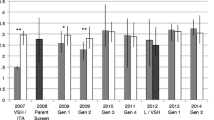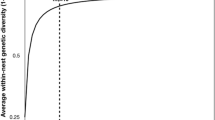Abstract
Social insect colonies provide ideal conditions for the spread of pathogens. It has been proposed that the extreme polyandry and genetic diversity seen in the colonies of some eusocial insect species is central to a colony’s defence against disease. Indeed, empirically, colonies headed by polyandrous queens have lower incidence of pathogens than genetically uniform monoandrous colonies. The mechanisms of improved resistance in genetically diverse colonies could arise from the genetic diversity among worker genotypes or from increased innate immunity arising from heterozygosity at immune gene loci within individual workers. Here, we investigate the effects of heterozygosity on two components of the honey bee (Apis mellifera) innate immune system: encapsulation and phenoloxidase (PO) activity. No significant effect of heterozygosity on immune system activity was evident for either encapsulation or PO activity. Thus, we conclude that while encapsulation and PO activity are important components of the immune response, it seems that they do not underlie the positive effects of genetic diversity on parasite and pathogen resistance in honey bees.



Similar content being viewed by others
References
Alaux C., Ducloz F., Crauser D. and LeConte Y. 2010. Diet effects on honeybee immunocompetence. Biol. Lett. 6: 562–565
Baer B., Krug A., Boomsma J.J. and Hughes W.O.H. 2005. Examination of the immune responses of males and workers of the leaf-cutting ant Acromyrmex echinatior and the effect of infection. Insect. Soc. 52: 298–303
Bienefeld K., Reinhardt F. and Pirchner F. 1989. Inbreeding effects of queen and workers on colony traits in the honey bee. Apidologie 20: 439–450
Brown M.J.F., Moret Y. and Schmid-Hempel P. 2003. Activation of host constitutive immune defence by an intestinal trypanosome parasite of bumble bees. Parasitology 126: 253–260
Brückner D. 1975. Die Abhängigkeit der Temperaturregulierung von der Genetischen Variabilität der Honigbiene (Apis mellifera) [Dependence of thermoregulation on the genetic variability in the honeybee]. Apidologie 6: 361–380
Brückner D. 1979. Effects of inbreeding on worker honeybees. Bee Wld. 60: 137–140
Brückner D. 1980. Hoarding behaviour and life span of inbred, non-inbred and hybrid honeybees. J. Apic. Res. 19: 35–41
Cale G.H. and Gowen J.W. 1956. Heterosis in the honey bee (Apis mellifera L). Genetics 41: 292–303
Calleri D.V., Reid E.M., Rosengaus R.B., Vargo E.L. and Traniello J.F.A. 2006. Inbreeding and disease resistance in a social insect: effects of heterozygosity on immunocompetence in the termite Zootermopsis angusticollis. Proc. R. Soc. Lond. B 273: 2633–2640
Crozier R.H. and Page R.E. 1985. On being the right size: male contributions and multiple mating in the social Hymenoptera. Behav. Ecol. Sociobiol. 18: 105–115
Drayton J.M. and Jennions M.D. 2011. Inbreeding and measures of immune function in the cricket Teleogryllus commodus. Behav. Ecol. 22: 486–492
Estoup A., Garnery L., Solignac M. and Cornuet J.-M. 1995. Microsatellite variation in honey bee (Apis mellifera L.) populations: Hierarchical genetic structure and tests of the infinite allele and stepwise mutation models. Genetics 140: 679–695
Evans J.D., Aronstein K., Chen Y.P., Hetru C., Imler J.L., Jiang H., Kanost M., Thompson G.J., Zou Z. and Hultmark D. 2006. Immune pathways and defence mechanisms in honey bees Apis mellifera. Ins. Mol. Biol. 15: 645–656
Evans J.D. and Pettis J.S. 2005. Colony-level impacts of immune responsiveness in honey bees Apis mellifera. Evolution 59: 2270–2274
Evans J.D. and Spivak M. 2010. Socialized medicine: Individual and communal disease barriers in honey bees. J. Invert. Pathol. 103: 562–572
Gerloff C.U., Ottmer B.K. and Schmid-Hempel P. 2003. Effects of inbreeding on immune response and body size in a social insect, Bombus terrestris. Func. Ecol. 17: 582–589
Haag-Liautard C., Vitikainen E., Keller L. and Sundström L. 2009. Fitness and the level of homozygosity in a social insect. J. Evol. Biol. 22: 134–142
Harbo J.R. 1986 Propagation and Instrumental Insemination. In: Bee Genetics and Breeding (Rinderer T.E., Ed). Academic Press, Orlando, pp 361–389
Hughes W.O.H. and Boomsma J.J. 2004. Genetic diversity and disease resistance in leaf-cutting ant societies. Evolution 58: 1251–1260
Hughes W.O.H., Eilenberg J. and Boomsma J.J. 2002. Trade-offs in group living: transmission and disease resistance in leaf-cutting ants. Proc. R. Soc. Lond. B 269: 1811–1819
Hughes W.O.H., Ratnieks F.L.W. and Oldroyd B.P. 2008. Multiple paternity or multiple queens: two routes to greater intracolonial genetic diversity in the eusocial Hymenoptera. J. Evol. Biol. 21: 1090–1095
Invernizzi C., Peñgaricino F. and Tomasco I.U. 2009. Intracolonial genetic variability in honeybee larval resistance to the chalk brood and American foulbrood parasites. Insect. Soc. 56: 233–240
Jones J.C., Helliwell P., Beekman M., Maleszka R.J. and Oldroyd B.P. 2005. The effects of rearing temperature on developmental stability and learning and memory in the honey bee, Apis mellifera. J. Comp. Physiol. A. 191: 1121–1129
Keller L.F. and Waller D.M. 2002. Inbreeding effects in wild populations. Trends Ecol. Evol. 17: 230–241
Lowe E.C., Simmons L.W. and Baer B. 2011. Worker heterozygosity and immune response in feral and managed honeybees (Apis mellifera). Aust. J. Zool. 59: 73–78
Oldroyd B.P. and Fewell J.H. 2007. Genetic diversity promotes homeostasis in insect colonies. Trends Ecol. Evol. 22: 408–413
Page R.E. 1980. The evolution of multiple mating behavior by honey bee queens (Apis mellifera L.). Genetics 96: 263–273
Page R.E. and Laidlaw H.H. 1982. Closed population honeybee breeding. 1. Population genetics of sex determination. J. Apic. Res. 21: 30–37
Palmer K.A. and Oldroyd B.P. 2000. Evolution of multiple mating in the genus Apis. Apidologie 31: 235–248
Palmer K.A. and Oldroyd B.P. 2003. Evidence for intra-colonial genetic variance in resistance to American foulbrood of honey bees (Apis mellifera): Further support for the parasite/pathogen hypothesis for the evolution of polyandry. Naturwissenschaften 90: 265–268
Rueppell O., Hayworth M.K. and Ross N.P. 2010. Altruistic self-removal of health-compromised honey bee workers from their hive. J. Evol. Biol. 23: 1538–1546
Schmid-Hempel P. 1998. Parasites in Social Insects. Princeton University Press, Princeton
Schmid-Hempel P. 2005. Evolutionary ecology of insect immune defenses. Annu. Rev. Entomol. 50: 529–551
Sherman P.W., Seeley T.D. and Reeve H.K. 1988. Parasites, pathogens and polyandry in social hymenoptera. Am. Nat. 131: 602–610
Simone M., Evans J.D. and Spivak M. 2009. Resin collection and social immunity in honey bees. Evolution 63: 3016–3022
Strand M.R. 2008. The insect cellular immune response. Insect Science 15: 1–14
Tarpy D.R. 2003. Genetic diversity within honeybee colonies prevents severe infections and promotes colony growth. Proc. R. Soc. Lond. B 270: 99–103
Tarpy D.R. and Seeley T.D. 2006. Lower disease infections in honeybee (Apis mellifera) colonies headed by polyandrous vs monandrous queens. Naturwissenschaften 93: 195–199
Walsh P.S., Metzger D.A. and Higuchi R. 1991. Chelex (R)100 as a medium for simple extraction of DNA for PCR-based typing from forensic material. Biotechniques 10: 507
Whitehorn P.R., Tinsley M.C., Brown M.J.F., Darvill B. and Goulson D. 2011. Genetic diversity, parasite prevalence and immunity in wild bumblebees. Proc. R. Soc. Lond. B 278: 1195–1202
Wilson-Rich N., Dres S.T. and Starks P.T. 2008. The ontogeny of immunity: Development of innate immune strength in the honey bee Apis mellifera J. Insect Physiol. 54: 1392–1399
Wilson-Rich N., Spivak M., Fefferman N.H. and Starks P.T. 2009. Genetic, individual and group facilitation of disease resistance in insect societies. Annu. Rev. Entomol. 54: 405–423
Wilson-Rich N., Tarpy D.R. and Starks P.T. 2012. Within- and across-colony effects of hyperpolyandry on immune function and body condition in honey bees (Apis mellifera). J. Insect Physiol. 58: 402–407
Woyke J. 1980. Effect of sex allele homo-heterozygosity on honeybee colony populations and on their honey production. J. Apic. Res. 19: 51–63
Acknowledgments
We thank Michael Duncan for technical assistance and Peter M. McGee for his comments on the manuscript. MJFB was funded by a BBSRC ISIS grant BB/J019453/1.
Author information
Authors and Affiliations
Corresponding author
Rights and permissions
About this article
Cite this article
Lee, G.M., Brown, M.J.F. & Oldroyd, B.P. Inbred and outbred honey bees (Apis mellifera) have similar innate immune responses. Insect. Soc. 60, 97–102 (2013). https://doi.org/10.1007/s00040-012-0271-5
Received:
Revised:
Accepted:
Published:
Issue Date:
DOI: https://doi.org/10.1007/s00040-012-0271-5




